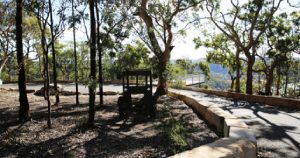In selecting suitable small species for smaller gardens there are several factors which need to be considered. Firstly, you need to decide what you mean by "small". For the purpose of this article I have adopted a maximum height of about 10 metres (30 feet) or smaller. Then you need to consider the local growing conditions in comparison to the conditions of the natural habitat of the various species.
Some trees may only grow to shrub size, with a naturally branched habit, but can be trained into a single trunk tree.
The first tree that springs to my mind is Tristaniopsis laurina (Water Gum). It is a small spreading tree with handsome leaves and beautiful pale bare sheen to the bark and dense clusters of yellow flowers
around Christmas. Although its natural habitat in this area is along rocky creeks in sandstone gullies, it is quite adaptable to various soils and conditions.
Acmena smithii (Lillypilly) is a small tree with dense dark glossy foliage that grows quite tall in rainforest gullies, but is much shorter in the open garden situation.
Backhousia myrtifolia (Grey Myrtle) is usually found along banks of streams, but can grows on drier hillsides. It has dull dark green foliage and the young branches are covered in fine grey hair. It has cream coloured flowers in summer.
Many of the Bottlebrushes are large shrubs and can form tree- like trunks. Callistemon salignus (Willow Bottlebrush) has a corky bark and creamy flowers, while Callistemon citrinus (Crimson Bottlebrush) has bright red flowers.
Melaleuca linariifolia (Snow- in-summer) is an adaptable small tree with papery bark. It puts on an extraordinary display of white flowers in summer.
Other local native favourites of mine are: Elaeocarpus reticulates (Blueberry Ash), with its fringed flowers and pretty blue berries, Trema tomentose (Native Peach), and Ceratopetalum gummiferum (NSW Christmas Bush).
So why not try one of the above selection when looking for a small tree or large shrub for your garden.
Contacts: www.stillcreeklandcare.com.au or Facebook






